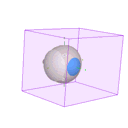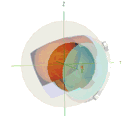
Matrix bounds
The 3D matrix bounds are 20 mm lateral to the plaque's central axis (CAX), 5 mm behind the plaque, and 40 mm in front of the plaque. Dose outside these bounds is assumed to be zero. The 3D matrix has nonuniform density. The spacing between calculation points varies between 0.5 and 1.0 mm laterally and between 0.25 and 2.0 mm in front of (and behind) the plaque with the greatest calculation point density at the plaque face. The matrix data are normalized to a point 2.5 mm in front of the plaque on the CAX. When the matrix is used for isodose calculations, only dose to the normalization point needs to be recalculated to adjust to changes of implant date and/or duration.

Isodose surface
The 3D matrix is referenced to the coordinate system of the "active" plaque. Illustrated to the left are the matrix bounds and the 85 Gy isodose surface of a BEBIG CCB plaque.